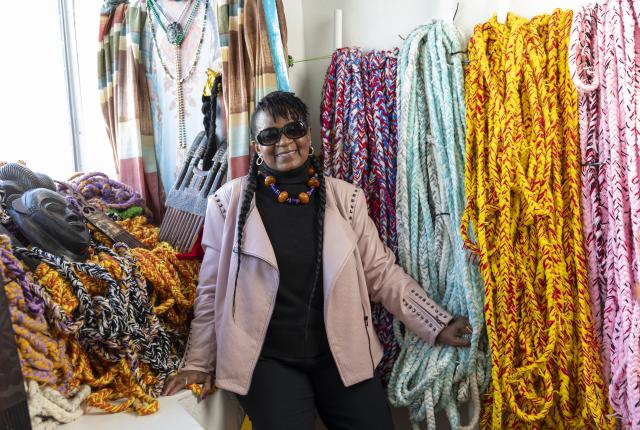Above: Hiddekel Sara Burks sits inside the New Mexico Holocaust Museum and Gellert Center for Education crafting a coiled, multicolored braid that’s more than 4,000 feet long and growing. Photograph by Gabriella Marks.
IN THE SUN-DRENCHED FRONT WINDOW of the New Mexico Holocaust Museum and Gellert Center for Education, in downtown Albuquerque, Hiddekel Sara Burks sits surrounded by yarn, crafting a coiled, multicolored braid that’s more than 4,000 feet long and growing.
Wearing long plaits, Burks braids three hours a day, four times a week, in the museum’s front window, surrounded by vintage portraits of people wearing natural hairstyles she created for them as a licensed cosmetologist.
Each color or section celebrates motherhood, some part of the Black natural hair experience, or Black hair pioneers such as Cicely Tyson, Whoopi Goldberg, and James Brown. One bright red section represents a little girl who wasn’t allowed to take a school picture because she had red braids as part of her hairstyle.
“The braid tells a story,” says Burks, who founded the first professional braiding salon in her native Chicago. “It has a voice.”
When a detached retina caused her to retire from nursing two years ago, Burks moved to New Mexico to be closer to her sons. She began looking for a project that might combine her interests, acknowledge her recovery from several eye surgeries, and make a larger statement. As the founder of the National Braiders Guild, she had already completed three other longest-braid projects and, throughout her career, advocated for clients who often had to fight for their right to wear braids or other natural hairstyles that were considered inappropriate or unprofessional. “I have a love and a passion for this art form,” says Burks.
Around the same time, she learned of an effort in California to pass the crown Act, a law making it illegal to discriminate in the workplace for wearing natural hairstyles such as Afros, natural curls, and locs. “Before, beautiful Black women could walk in with all the credentials in the world and they’d look at your hair and you wouldn’t get the job,” says Burks. When she saw news of the CROWN Act, she realized, “This is bigger than me. This is a celebration. We don’t need anyone to validate us anymore.”
So Burks researched the world’s longest textile braid and found the Guinness World Record was held by some children who had stopped 73 feet short of a mile. “Inspiration is my superpower,” says Burks. “Those kids inspired me.”
She wanted to eclipse a mile, and set her goal at 6,000 feet. In early 2020, she began working in the Coronado Center atrium with skeins of donated yarn and a broad list of sponsors. Then covid-19 hit. Although the exhibit was quickly shut down, the short-term exposure and interactive nature of the display—folks wanting a closer look and asking questions—caused Burks to fall ill. She recovered, but asked Guinness to put her project on an official pause, because the requirements say the work must be done in public.
After a 16-month hiatus, she resumed braiding at the Holocaust Museum. “Things like that will propel you and fortify you,” says Burks, who expects to finish the project this fall.
“I count her as an inspiration to the work we were doing,” says Alexandria Taylor, a founding member of the New Mexico Black Central Organizing Committee, which worked to pass crown Act legislation in Albuquerque and the New Mexico Legislature. “We love and respect and honor all that she’s done.”
True Heroes
Read more about the 10 individuals who went above and beyond to support our communities.


